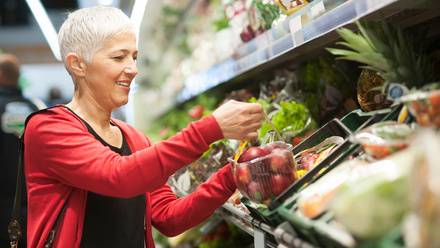This Food Fact Sheet looks at salt in our diet. It covers how to find foods that are too high in salt and gives tips on how to reduce the amount of salt that we eat.
Salt and health
Many cells make up our body tissues. They have different shapes, sizes and functions. All of these cells need enough salt to work properly.
Salt is vital for two reasons:
- It helps transport water around the body.
- It helps send messages between the brain and the body.
However, as with most things, too much salt can cause problems. Too much salt can cause water retention, high blood pressure, and a higher risk of heart attack, kidney disease and stroke. So, it is best to keep amount of salt that we eat to safe limits.

Salt and everyday foods
Many everyday foods do not taste salty, but they can contain high amounts of hidden salt. We also might add salt to our food when cooking or just before eating.
Around 75% of the salt we eat is already in the foods we buy. Most of this comes from salt added to processed foods. These include snacks like crisps and biscuits, ready meals, soups and pasta sauces. Even breads and cereals can contain a lot of salt.
Reducing the amount of processed foods we eat can help reduce the amount of salt we consume. Checking food labels can help us find out how much salt is in the food we are eating.
How do I know which foods contain a lot of salt?
Traffic light labelling is currently voluntary in the UK but where it is used it can help us make healthier choices. The traffic light system colours help us to quickly see a food's nutrient levels in 100g. They show high, medium, or low amounts. Wherever possible aim for products that contain low (green) or medium (amber) levels of salt. For foods that don’t display the traffic light label, here is a handy guide:
|
|
Low |
Medium |
High |
|---|---|---|---|
|
Salt |
Less than 0.3g |
0.3g - 1.5g |
More than 1.5g |
|
Sodium |
Less than 0.1g |
0.1g - 0.6g |
More than 0.6g |
How much is too much salt?
In the UK, the Scientific Advisory Committee on Nutrition (SACN) recommends the following maximum salt intake in children and adults:
| Age | Maximum salt (grams per day) |
| 1- 3 years | 2g |
| 4- 6 years | 3g |
| 7- 10 years | 5g |
| 11 years and older | 6g |
It is recommended not to add salt to baby food or offer foods to them that are high in salt e.g. stock cubes, gravy.
How can we be more salt aware?
- Use little or no salt in cooking – use extra herbs and spices instead.
- Leave the salt shaker off the table.
- Cut down on salty processed foods and ready meals –Cook at home if possible.
- For foods that are high in salt (for example, cheese, smoked/cured meat and fish, olives, meat/yeast extract), aim to eat these less often and in smaller quantities.
- Check food labels for salt and go for lower-salt choices (green and amber on the traffic light labelling).
- Some store cupboard products (for example, gravy, stock cubes, soy sauce) can be high in salt.
- If buying tinned vegetables and pulses, choose options without added salt.
- If buying tinned fish choose options that are not tinned in brine (salt water).
- Switch salty snacks (for example, crisps, biscuits, salted nuts) for fruit, vegetable sticks, or try options that don’t have added salt.
- In restaurants and takeaways ask that salt is not added to the meal.
- Beware of gourmet salts and salt substitutes. They may claim to be healthier than table salt. But they are likely to still increase salt intake.
Sodium vs salt: What’s the difference?
Salt is used as the everyday term for sodium chloride, a chemical compound. It is made from two components, sodium and chlorine, which gives it this name. Some manufacturers may mention the sodium content on their food labels but this is not required by law. Each 1g of sodium equals 2.5g of salt so keep this in mind when monitoring how much salt you eat.
Top tips
Most of us eat too much salt. Eating too much salt can lead to high blood pressure which can have significant health risks. Eating less salt can greatly improve our health. To reduce the salt that we eat:
- Use less salt when cooking and at the table
- Eat fewer processed foods
- Check food labels and choose lower salt options
Source(s)
Consensus Action on Salt – Salt intake and the health of your children leaflet. Available from https://www.actiononsalt.org.uk/resources/leaflets/ [Accessed 12 November 2024]
Gillison F, Grey E, Verplanken B, Barnett J & Baber F (2022). "A rapid review of the acceptability and impact of approaches to reduce the salt, fat and sugar content of people’s diets on consumers and industry."
Scientific Advisory Committee on Nutrition. Salt and Health. 2003. Available from https://assets.publishing.service.gov.uk/media/5a74983de5274a44083b7ef6/SACN_Salt_and_Health_report.pdf [Accessed 12 November 2024]
Department of Health (2017). Technical Guidance on Nutrition Labelling. Available from https://assets.publishing.service.gov.uk/media/5a8010d8e5274a2e87db7a62/Nutrition_Technical_Guidance.pdf [Accessed 12 November 2024]
Department of Health (2013). Guide to creating a front of pack (FoP) nutrition label for pre-packed products sold through retail outlets. Available from https://www.food.gov.uk/sites/default/files/media/document/fop-guidance_0.pdf [Accessed 12 November 2024]







